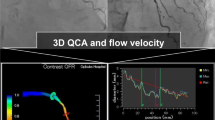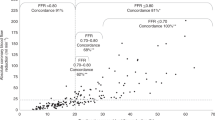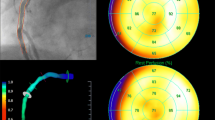Abstract
Quantitative flow ratio (QFR) is a recently proposed angiographic index that allows to assess the pressure loss in coronary arteries in a similar fashion as the fractional flow reserve (FFR). The purpose of this study was to evaluate the diagnostic performance of QFR as compared to FFR, in a Latin-American population of patients with suspected ischaemic heart disease. QFR was retrospectively derived from coronary angiograms. The association, diagnostic performance, and continuous agreement of fixed-flow QFR (fQFR) and contrast-flow QFR (cQFR) with FFR was assessed by continuous and dichotomous methods. 90 vessels form 66 patients were finally included. The study comprised coronary stenoses of intermediate severity, both angiographically (diameter stenosis: 46.6 ± 12.8%) and physiologically [median FFR = 0.83 (quartile 1–3, 0.76–0.89)]. The correlation of FFR with both fQFR [ρ = 0.841, (95% CI 0.767 to 0.893), p < 0.001] and cQFR [ρ = 0.833, (95% CI 0.755 to 0.887), p < 0.001] was strong. The diagnostic performance of cQFR was good [area under the ROC curve of 0.92 (95% CI 0.86 to 0.97, p < 0.001)], with 0.80 as the optimal cQFR cut-off against FFR ≤ 0.80. This 0.80 cQFR cut-off classified correctly 83.3% of total stenoses, with a sensitivity of 85.2% and specificity of 80.6%. QFR was strongly associated with FFR and exhibited a high diagnostic performance in this Latin-American population.





Similar content being viewed by others
References
Knuuti J, Wijns W, Saraste A, Capodanno D, Barbato E, Funck-Brentano C, Prescott E, Storey RF, Deaton C, Cuisset T, Agewall S, Dickstein K, Edvardsen T, Escaned J, Gersh BJ, Svitil P, Gilard M, Hasdai D, Hatala R, Mahfoud F, Masip J, Muneretto C, Valgimigli M, Achenbach S, Bax JJ, ESC Scientific Document Group (2020) 2019 ESC guidelines for the diagnosis and management of chronic coronary syndromes. Eur Heart J 41:407–477
van de Hoef TP, Lee JM, Echavarria-Pinto M, Koo B-K, Matsuo H, Patel MR, Davies JE, Escaned J, Piek JJ (2020) Non-hyperaemic coronary pressure measurements to guide coronary interventions. Nat Rev Cardiol 17:629–640
Tu S, Westra J, Yang J, von Birgelen C, Ferrara A, Pellicano M, Nef H, Tebaldi M, Murasato Y, Lansky A, Barbato E, van der Heijden LC, Reiber JHC, Holm NR, Wijns W, FAVOR Pilot Trial Study Group (2016) Diagnostic accuracy of fast computational approaches to derive fractional flow reserve from diagnostic coronary angiography: the international multicenter FAVOR Pilot study. JACC Cardiovasc Interv 9:2024–2035
Duarte A, Llewellyn A, Walker R, Schmitt L, Wright K, Walker S, Rothery C, Simmonds M (2021) Non-invasive imaging software to assess the functional significance of coronary stenoses: a systematic review and economic evaluation. Health Technol Assess Winch Engl 25:1–230
Overview | QAngio XA 3D QFR and CAAS vFFR imaging software for assessing coronary stenosis during invasive coronary angiography | Guidance | NICEhttps://www.nice.org.uk/guidance/dg43. Accessed 14 Jan 2022
Fuensalida A, Vergara F, Hameau R, Quitral J, Sepúlveda P, Martínez A, Valenzuela E, Martínez G (2021) Evaluación no invasiva de la significancia funcional de las lesiones coronarias mediante Quantitative Flow Ratio (QFR). Validación con Reserva de Flujo Fraccional (FFR). Rev Chil Cardiol 40:96–103
Escaned J, Echavarría-Pinto M, Garcia-Garcia HM, van de Hoef TP, de Vries T, Kaul P, Raveendran G, Altman JD, Kurz HI, Brechtken J, Tulli M, Von Birgelen C, Schneider JE, Khashaba AA, Jeremias A, Baucum J, Moreno R, Meuwissen M, Mishkel G, van Geuns R-J, Levite H, Lopez-Palop R, Mayhew M, Serruys PW, Samady H, Piek JJ, Lerman A, ADVISE II Study Group (2015) Prospective assessment of the diagnostic accuracy of instantaneous wave-free ratio to assess coronary stenosis relevance: results of ADVISE II international, multicenter study (ADenosine Vasodilator Independent Stenosis Evaluation II). JACC Cardiovasc Interv 8:824–833
Xu B, Tu S, Song L, Jin Z, Yu B, Fu G, Zhou Y, Wang J, Chen Y, Pu J, Chen L, Qu X, Yang J, Liu X, Guo L, Shen C, Zhang Y, Zhang Q, Pan H, Fu X, Liu J, Zhao Y, Escaned J, Wang Y, Fearon WF, Dou K, Kirtane AJ, Wu Y, Serruys PW, Yang W, Wijns W, Guan C, Leon MB, Qiao S, Stone GW, FAVOR III China study group (2021) Angiographic quantitative flow ratio-guided coronary intervention (FAVOR III China): a multicentre, randomised, sham-controlled trial. Lancet Lond Engl 398(10317):2149–2159
Buderer NM (1996) Statistical methodology: I. Incorporating the prevalence of disease into the sample size calculation for sensitivity and specificity. Acad Emerg Med Off J Soc Acad Emerg Med 3:895–900
Zimmermann FM, Omerovic E, Fournier S, Kelbæk H, Johnson NP, Rothenbühler M, Xaplanteris P, Abdel-Wahab M, Barbato E, Høfsten DE, Tonino PAL, Boxma-de Klerk BM, Fearon WF, Køber L, Smits PC, De Bruyne B, Pijls NHJ, Jüni P, Engstrøm T (2019) Fractional flow reserve-guided percutaneous coronary intervention vs medical therapy for patients with stable coronary lesions: meta-analysis of individual patient data. Eur Heart J 40:180–186
Westra J, Andersen BK, Campo G, Matsuo H, Koltowski L, Eftekhari A, Liu T, Di Serafino L, Di Girolamo D, Escaned J, Nef H, Naber C, Barbierato M, Tu S, Neghabat O, Madsen M, Tebaldi M, Tanigaki T, Kochman J, Somi S, Esposito G, Mercone G, Mejia-Renteria H, Ronco F, Bøtker HE, Wijns W, Christiansen EH, Holm NR (2018) diagnostic performance of in-procedure angiography-derived quantitative flow reserve compared to pressure-derived fractional flow reserve: the FAVOR II europe-japan study. J Am Heart Assoc 7:e009603
Xu B, Tu S, Qiao S, Qu X, Chen Y, Yang J, Guo L, Sun Z, Li Z, Tian F, Fang W, Chen J, Li W, Guan C, Holm NR, Wijns W, Hu S (2017) Diagnostic accuracy of angiography-based quantitative flow ratio measurements for online assessment of coronary stenosis. J Am Coll Cardiol 70:3077–3087
Acknowledgements
MEP acknowledges the staff and Directive Team of Hospital General ISSSTE Querétaro for their support for the development of this project.
Funding
The authors have not disclosed any funding.
Author information
Authors and Affiliations
Corresponding author
Ethics declarations
Conflict of interest
MEP, TPH, HGG have served as speakers in educational events organized Boston Scientific and Abbot, developers of pressure wires.
Additional information
Publisher's Note
Springer Nature remains neutral with regard to jurisdictional claims in published maps and institutional affiliations.
Rights and permissions
About this article
Cite this article
Echavarría-Pinto, M., Van de Hoef, T.P., Pacheco-Beltran, N. et al. Diagnostic agreement of quantitative flow ratio with fractional flow reserve in a Latin-American population. Int J Cardiovasc Imaging 38, 1423–1430 (2022). https://doi.org/10.1007/s10554-022-02547-6
Received:
Accepted:
Published:
Issue Date:
DOI: https://doi.org/10.1007/s10554-022-02547-6




